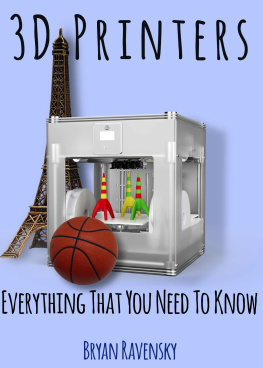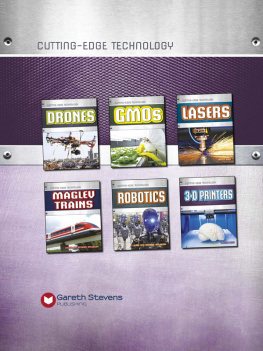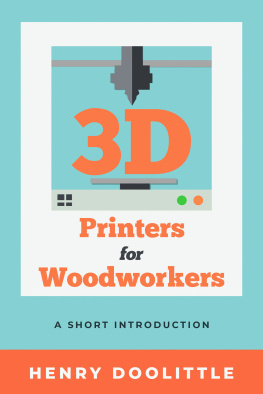Bryan Ravensky - 3D Printers: Everything That You Need To Know
Here you can read online Bryan Ravensky - 3D Printers: Everything That You Need To Know full text of the book (entire story) in english for free. Download pdf and epub, get meaning, cover and reviews about this ebook. year: 0, genre: Children. Description of the work, (preface) as well as reviews are available. Best literature library LitArk.com created for fans of good reading and offers a wide selection of genres:
Romance novel
Science fiction
Adventure
Detective
Science
History
Home and family
Prose
Art
Politics
Computer
Non-fiction
Religion
Business
Children
Humor
Choose a favorite category and find really read worthwhile books. Enjoy immersion in the world of imagination, feel the emotions of the characters or learn something new for yourself, make an fascinating discovery.
- Book:3D Printers: Everything That You Need To Know
- Author:
- Genre:
- Year:0
- Rating:3 / 5
- Favourites:Add to favourites
- Your mark:
- 60
- 1
- 2
- 3
- 4
- 5
3D Printers: Everything That You Need To Know: summary, description and annotation
We offer to read an annotation, description, summary or preface (depends on what the author of the book "3D Printers: Everything That You Need To Know" wrote himself). If you haven't found the necessary information about the book — write in the comments, we will try to find it.
3D Printers: Everything That You Need To Know — read online for free the complete book (whole text) full work
Below is the text of the book, divided by pages. System saving the place of the last page read, allows you to conveniently read the book "3D Printers: Everything That You Need To Know" online for free, without having to search again every time where you left off. Put a bookmark, and you can go to the page where you finished reading at any time.
Font size:
Interval:
Bookmark:
Contents:
Three-dimensional graphics or 3D
3D-printers
Types of 3 D printers
Commercialization of three-dimensional printing
Problems and ways of their solution
That it is possible to print on the printer
Imagin e a situation that you need urgently to get a chair or a table on kitchen. Now you, most likely, would go to normal shop behind this purchase. At best would look at goods on the Internet. But that day when you are able to receive a unique chair or a table not simply is already near, without leaving the house, but even without any mediation from sellers or the delivery service of shop. The main thing that at your place there was a 3D-printer.
You will only need to transfer money for a product by means of your credit card to the account of shop then it will be possible safely... print a product. And at desire you will be able even to load the 3D model of a table into the computer, having made it unique. Than not the real hand-made?
All this can seem you a fantasy. Then prepare. All this already functions. It is reality which is used for a solution of a narrow range of tasks so far. But mass implementation of technology in everyday life already not far off.
Three-dimensional graphics or 3D
Three-dimensional graphics or 3D the section of computer graphics, a set of methods and the tools (both program, and equipment rooms) designed to provide a spatio-temporal continuity of the received images. It is most of all applied to creation of images in architectural visualization, cinema, television, computer games, printed materials, and also in science and the industry.
The three-dimensional image differs from flat in creation of a geometrical projection of three-dimensional model of a scene on the computer screen by means of specialized programs.
At the same time the model can how to correspond to objects from the real world, well completely abstract.
For obtaining the three-dimensional image the following steps are required:
Modelin g creation of a mathematical model of a scene and objects in it.
Rendering (visualization) creation of a projection according to the selected physical model.
1.2. Modeling
The scene (virtual space of modeling) includes several categories of objects:
Geometry - the technician constructed by means of different model, for example the building.
Materials - information on visual properties of model, for example color of walls and the reflecting / refractive power of windows.
Light sources - settings of the direction, power, a lighting range
Virtual cameras - the choice of a point and angle of creation of a projection
Forces and influences - settings of dynamic distortions of objects, it is applied generally in animation
Additional effects - the objects imitating the atmospheric phenomena: light in fog, clouds, a flame and so forth.
1.3. Rendering
Rendering the term in computer graphics designating process of obtaining the image on model by means of the computer program.
At this stage the mathematical (vector) space model turns into the flat (raster) picture. If it is required to create the movie, then the sequence of such pictures - frame s is rendered. As a data structure, the image on the screen it is presented by a matrix of points where each point is defined, at least, by three numbers: intensity of red, blue and green color. Thus, rendering will transform a three-dimensional vector data structure to a flat matrix of pixels. This step often demands very difficult calculations, especially if it is required to create illusion of reality. The simplest type of rendering is to construct circuits of models on the computer screen by means of a projection. Usually it insufficiently it is also necessary to create illusion of materials of which objects are made, and also to calculate distortions of these objects at the expense of transparent environments (for example, liquids in a glass).
There are several technologies of rendering which are often combined together.
For example:
1. The Z-buffer (it is used in OpenGL and DirectX);
2. Scanline calculation of color of each point of the picture creation of a beam from the point of view of the observer through the imagined opening in the screen on site this pixel "to the stage" before intersection with the first surface. Color of pixel will be same as color of this surface.
. Ray tracing (raytracing) the same, as scanline, but color of pixel is specified due to creation of the additional beams (reflected, refracted etc.) from look beam crosspoint;
Global illumination (English global illumination, radiosity) calculation of interaction of surfaces and Wednesdays in a visible emission spectrum by means of integrable equations and others.
The most popular systems of rendering it is possible to call:
PhotoRealistic RenderMan (PRMan)
Mental ray
V-Ray
FinalRender
Brazil R/S
BusyRay
Turtle
Maxwell Render
Fryrender
Indigo Renderer
LuxRender
YafRay
POV-Ray
1.4. Use of 3D graphics
3D graphics very often meets in different areas of our life. Occasionally we do not notice that the photo published in advertizing actually is skillful three-dimensional model which is difficult for distinguishing from really photographed object.
3D graphics appears in games, the Internet, on television, billboards. 3D graphics design becomes more and more demanded service. Modern technologies in the field of three-dimensional graphics allow to apply 3D graphics in design not only separate objects, but also the whole worlds that opens new opportunities both before performers, and before customers of advertizing.
3D graphics is irreplaceable means in need of demonstration of any difficult technical nodes, multistage productions, architectural constructions. Tridimentionality visually displays all features of a structure of an object, its smallest elements hidden from eyes of the observer of a part of construction of a construction. Three-dimensional visualization is far more convenient and more evident, than drawings and schemes. It is connected with the fact that three-dimensional representation much more visual way of demonstration of all advantages of your product or service, than 2-d circuits or diagrams.
3D graphics finds broad application in technogenic spheres. The main consumers 3D are the producer companies of the different equipment and the organization which are engaged in construction of the large real estate. Three-dimensional graphics allows to show to hardware manufacturers very visually the principles of work of process lines and separate machines.
The "volume" design allows to emphasize advantages and subtleties of production. By means of 3D graphics there is an opportunity to show all equipment and to glance "in" technological process. Effective visualization concentrates attention of the viewer on the key moments of demonstration. The qualitative three-dimensional design has an ideal appearance that promotes positive perception of the presentation in general.
1.5. Program resources
The software packages allowing to create three-dimensional graphics, that is to model objects of virtual reality and to create on the basis of these models of the image are very different. The last years steady leaders in this area are commercial products:
DS Max the full-function professional program system for work with three-dimensional graphics developed by the Autodesk company. Works in the Microsoft Windows and Windows NT operating systems (both in 32-bit, and in 64-bit). In the spring of 2009 the twelfth version of this product under the name "3ds Max 2010" is released.
Maya the editor of three-dimensional graphics. Now became the 3D standard of graphics in cinema and television. It is originally developed for Irix OS (SGI platform), then it was ported under OS GNU/Linux, Microsoft Windows and Mac OS. Now exists both for 32, and for 64-bit systems.
Next pageFont size:
Interval:
Bookmark:
Similar books «3D Printers: Everything That You Need To Know»
Look at similar books to 3D Printers: Everything That You Need To Know. We have selected literature similar in name and meaning in the hope of providing readers with more options to find new, interesting, not yet read works.
Discussion, reviews of the book 3D Printers: Everything That You Need To Know and just readers' own opinions. Leave your comments, write what you think about the work, its meaning or the main characters. Specify what exactly you liked and what you didn't like, and why you think so.












